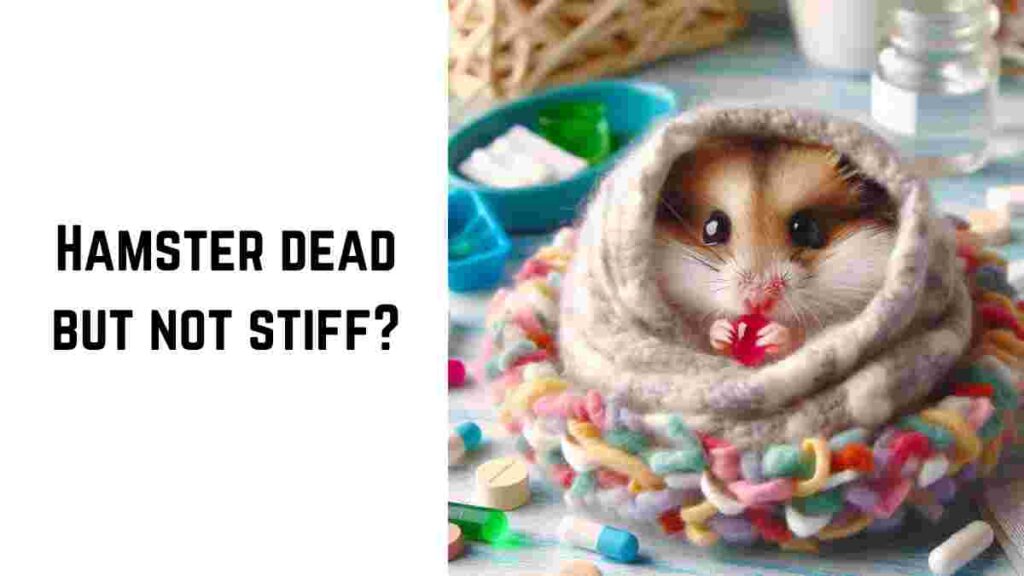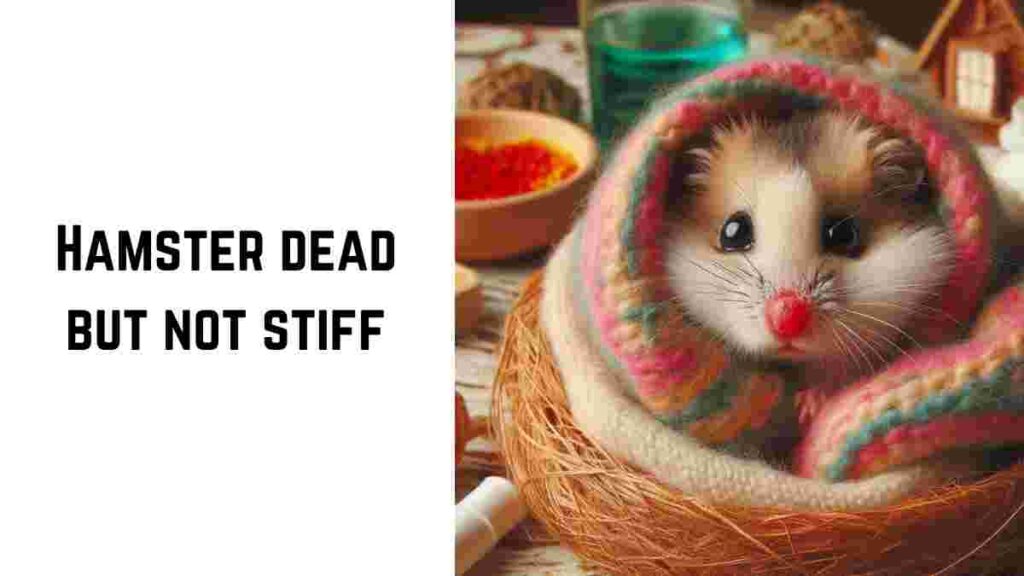Hamster Dead but Not Stiff: Hamsters are among the most beloved small pets worldwide, cherished for their playful nature, adorable appearance, and manageable care needs. However, like all pets, they have a limited lifespan, and their death can be a distressing experience for their owners. One particular phenomenon that can be quite perplexing is when a hamster dies but does not exhibit the characteristic rigor mortis, or stiffening of the body, that is typically expected after death.
This article aims to explore the various reasons why a hamster might die but not become stiff, offering detailed insights into the biological processes involved, potential implications for pet owners, and practical advice on how to handle such situations.
Let’s understand the topic in detail, “Hamster Dead but Not Stiff“.
Click here to ensure the best nutrition for your rodent friend
Find the best hamster wheels from here

Table of Contents
Understanding Rigor Mortis – Hamster Dead but Not Stiff
Before delving into the specifics of hamsters, it is essential to understand rigor mortis itself. Rigor mortis is a postmortem change resulting from chemical changes in the muscles after death, causing the limbs of the corpse to stiffen. This process typically begins within 2 to 6 hours after death and can last up to 72 hours, after which the body gradually relaxes again.
Rigor mortis occurs in three primary stages:
- Initial Phase: Immediately after death, the body is limp and flaccid due to the cessation of all muscular activity.
- Onset of Rigor: Within a few hours, the body starts to stiffen as adenosine triphosphate (ATP) reserves are depleted and calcium ions accumulate in the muscles.
- Resolution: After a day or two, the stiffness subsides as muscle proteins break down through autolysis and putrefaction.
Why Might a Hamster Not Exhibit Rigor Mortis? – Hamster Dead but Not Stiff
Several factors can influence the onset and duration of rigor mortis in hamsters. Here are some of the most common reasons why a hamster might die but not become stiff:
1. Temperature and Environment
Temperature is a critical factor in the onset and duration of rigor mortis. Hamsters are small animals with a high metabolic rate, and their bodies can cool down quickly after death, especially in cold environments. In colder temperatures, the biochemical processes that lead to rigor mortis slow down significantly, potentially delaying or even preventing the stiffness from becoming noticeable.
Conversely, in warm environments, rigor mortis can set in more rapidly and resolve more quickly as well. Therefore, the ambient temperature at the time of the hamster’s death can significantly influence the presence and duration of rigor mortis.
2. Cause of Death
The cause of death can also affect rigor mortis. Sudden deaths, such as those caused by trauma or acute health issues, might lead to a rapid onset of rigor mortis. However, if a hamster dies from a chronic illness or a prolonged decline, its body may be in a weakened state, and the metabolic processes leading to rigor mortis might be less pronounced or delayed.
3. Body Condition and Health at Time of Death
The overall health and body condition of the hamster at the time of death can impact rigor mortis. A hamster that has been ill or undernourished might not undergo the same rigor mortis process as a healthy one due to differences in muscle mass and biochemical reserves.
4. Timing of Discovery
Pet owners may find their hamster shortly after death, before rigor mortis has had a chance to set in. If the hamster is discovered within a couple of hours of passing away, the body may still be limp. Since rigor mortis begins a few hours after death and can last up to three days, discovering the hamster early on could mean that the stiffness is not yet apparent.
5. Unique Physiological Factors
Individual physiological differences can also play a role. Just as humans have variations in how their bodies respond to death, hamsters can also exhibit unique characteristics that influence rigor mortis. Factors such as muscle composition, age, and genetic predispositions might result in varying rigor mortis experiences among different hamsters.

Dealing with a Deceased Hamster – Hamster Dead but Not Stiff
Discovering that your hamster has died is undoubtedly a sad and often overwhelming experience. Here are some practical steps to take when handling a deceased hamster, particularly if rigor mortis is not yet evident:
1. Confirming Death
Before assuming your hamster is dead, ensure that it is not in a state of torpor, a temporary hibernation-like state that hamsters can enter when exposed to cold temperatures. Signs of torpor include shallow breathing and a lower body temperature, but the hamster may still be alive. Warm the hamster gently and observe for any signs of revival.
2. Handling the Body
If you are certain your hamster has passed away, handle the body with care. Use gloves or a clean cloth to avoid direct contact with bodily fluids. Place the body in a small box lined with soft material, such as a towel or tissue, to maintain its dignity and prevent damage during transport.
3. Choosing a Method of Disposition
Decide how you would like to handle the remains. Common options include:
- Home Burial: If you have a garden, you might choose to bury your hamster at home. Ensure the burial site is at least two feet deep to prevent scavengers from disturbing it.
- Pet Cemetery: Some areas have pet cemeteries where you can bury your hamster with other beloved pets.
- Cremation: Veterinary clinics often offer pet cremation services. You can choose to keep the ashes in a memorial urn or scatter them in a meaningful location.
Coping with Grief – Hamster Dead but Not Stiff
The loss of a pet can be deeply emotional. Here are some tips for coping with the grief of losing a beloved hamster:
- Allow Yourself to Grieve: It’s important to acknowledge your feelings and give yourself permission to mourn. Grieving is a personal process and there is no right or wrong way to do it.
- Create a Memorial: Consider creating a small memorial or tribute to your hamster. This could be a photo album, a dedicated spot in your garden, or even a simple drawing.
- Talk to Others: Sharing your feelings with friends, family, or online communities who understand the bond between pet and owner can provide comfort and support.
- Consider a New Pet: When you feel ready, adopting a new pet can help fill the void left by your hamster. A new companion won’t replace the one you’ve lost but can bring new joy and companionship into your life.

Frequently Asked Questions (FAQ) – Hamster Dead but Not Stiff
How long does rigor mortis last in hamsters?
Rigor mortis typically lasts from a few hours up to 72 hours in hamsters, depending on factors such as temperature and the cause of death.
Can hamsters go into hibernation and appear dead?
Yes, hamsters can enter a state of torpor, especially in cold temperatures, which can make them appear dead. It’s important to check for signs of life such as shallow breathing and attempt to warm them gently before assuming they have died.
Why is my hamster limp even though it’s dead?
If your hamster is limp despite being dead, it may be because rigor mortis has not yet set in. This process can take a few hours to begin, so a recently deceased hamster might still be flexible.
How should I dispose of my deceased hamster?
You can choose to bury your hamster at home, take it to a pet cemetery, or opt for cremation services provided by veterinary clinics. The method of disposition depends on your personal preference and local regulations.
Is it normal to feel intense grief after the loss of a hamster?
Yes, it is entirely normal to feel deep sadness after the loss of a pet, including a hamster. Pets often become beloved family members, and grieving their loss is a natural and important process.
Can other pets in the household be affected by the death of a hamster?
Other pets may notice the absence of the hamster and show signs of curiosity or mild distress. However, most pets will adjust to the change in environment relatively quickly.
Should I get a new hamster immediately after one dies?
It is a personal decision when to get a new pet. Some people find comfort in getting a new hamster soon after, while others prefer to take time to grieve before considering another pet. Make sure you are emotionally ready for the responsibility of a new pet.
Wrapping Up – Hamster Dead but Not Stiff
In conclusion, understanding the reasons why a hamster might die but not exhibit rigor mortis can help pet owners navigate this difficult experience with more knowledge and confidence. Whether it is due to environmental factors, the cause of death, or individual physiological differences, being informed about these possibilities can provide some peace of mind.
Additionally, knowing how to handle the deceased hamster and cope with the subsequent grief is essential for honoring the memory of your beloved pet and finding comfort during a challenging time.
Hope now the topic “Hamster Dead but Not Stiff” is clear to you.
